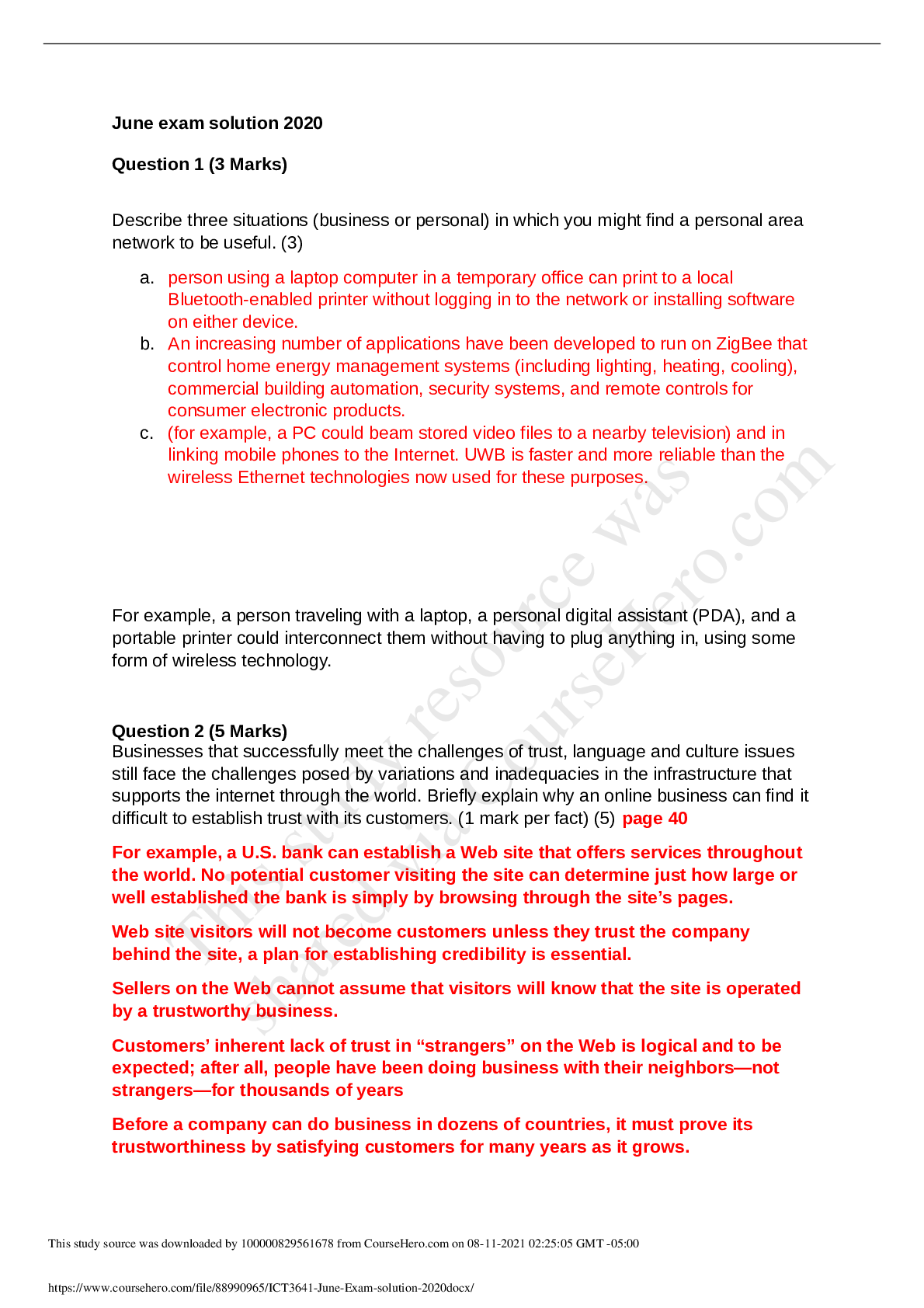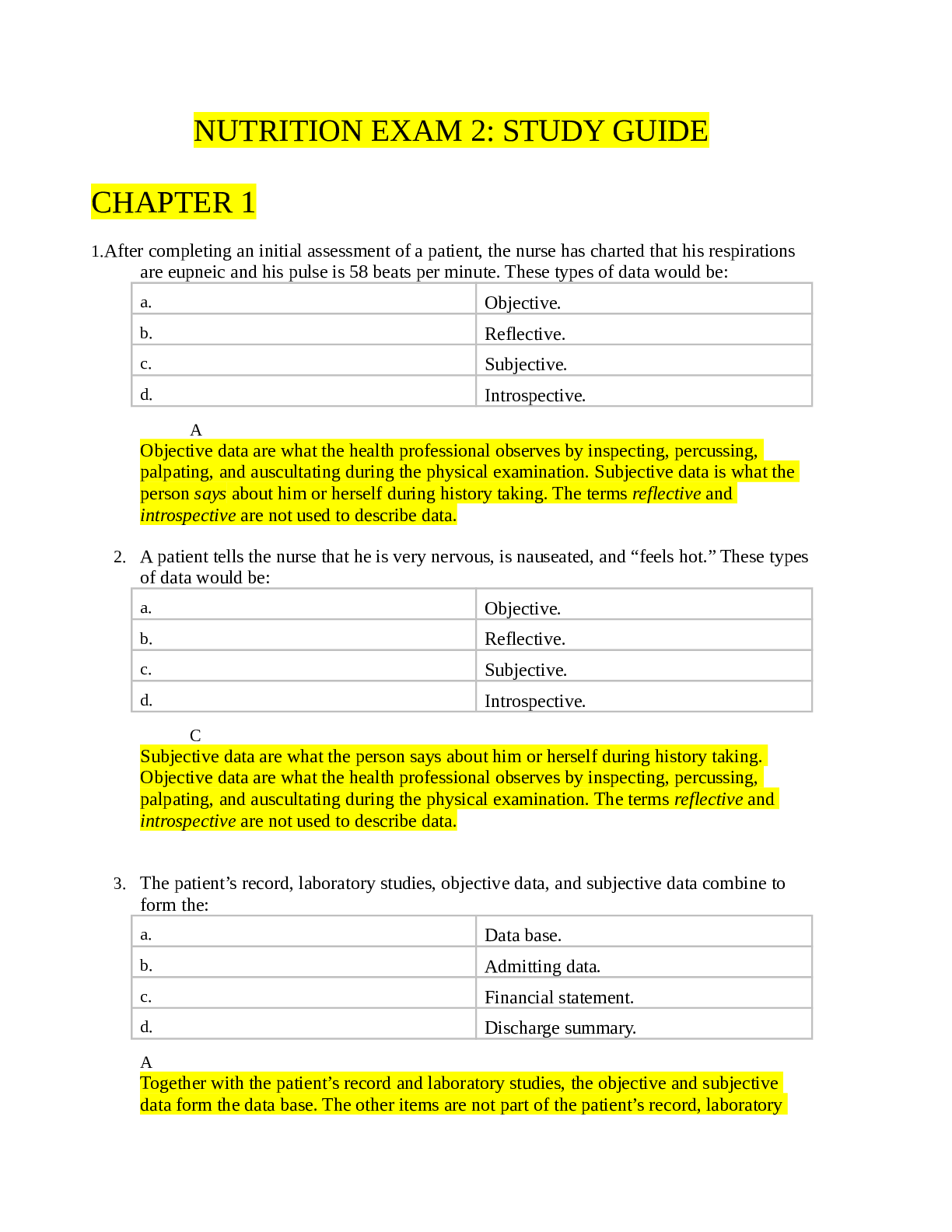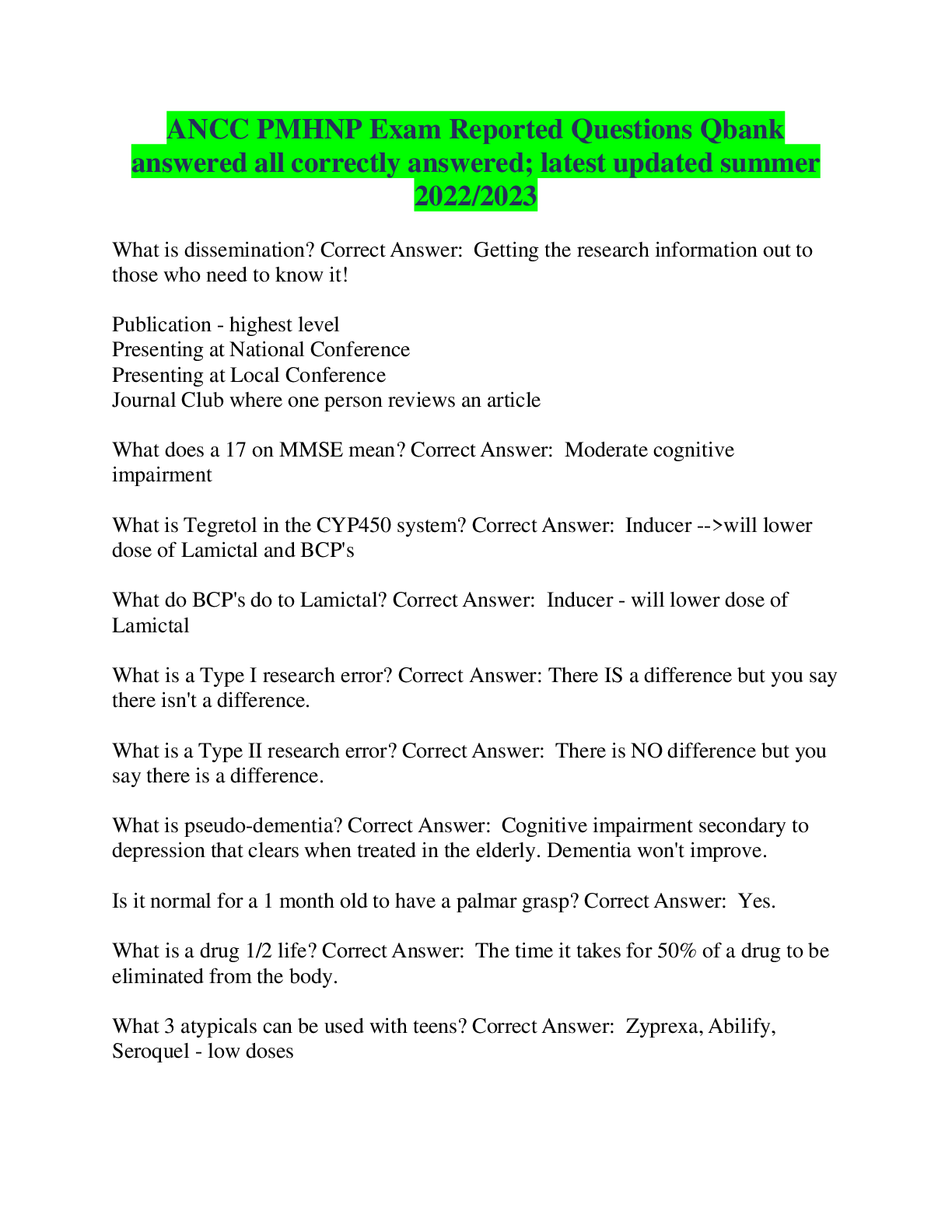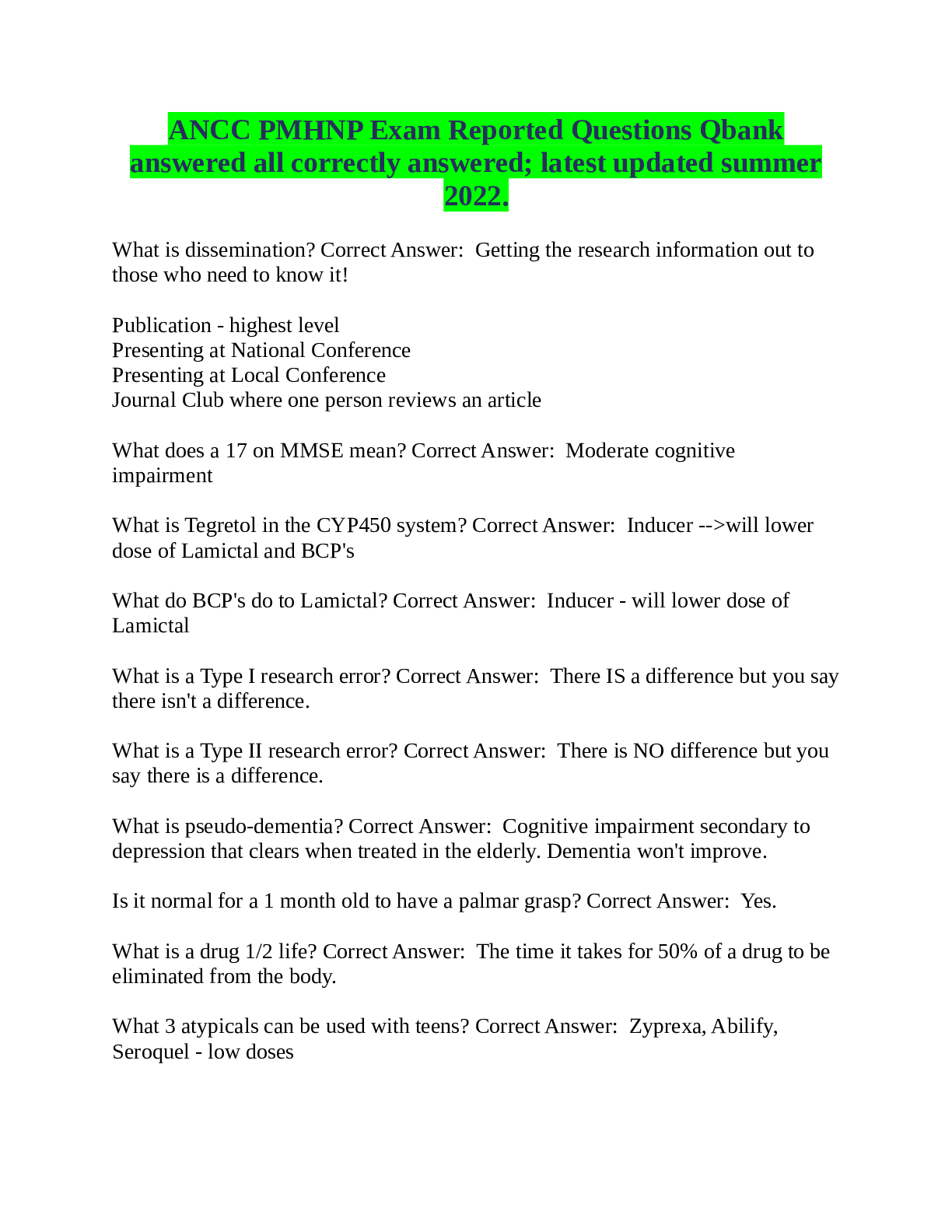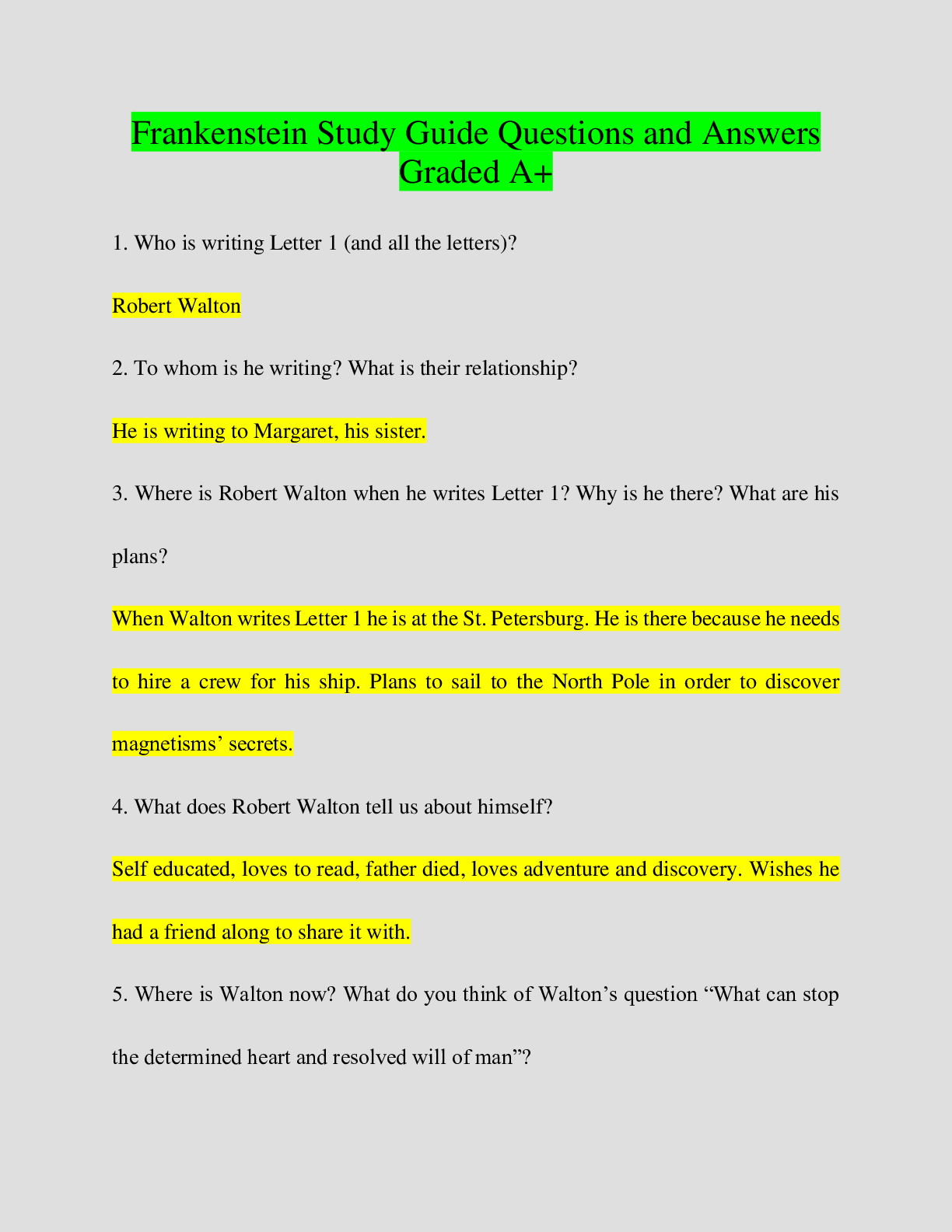*NURSING > EXAM REVIEW > Chapter 09:Health Assessment Exam 2: Study Guide Questions All correctly Answered and with Explanati (All)
Chapter 09:Health Assessment Exam 2: Study Guide Questions All correctly Answered and with Explanation - Frequently Examined Questions.
Document Content and Description Below
1. The nurse is performing a general survey. Which action is a component of the general survey? a. Observing the patient’s body stature and nutritional status b. Interpreting the subjective info... rmation the patient has reported c. Measuring the patient’s temperature, pulse, respirations, and blood pressure d. Observing specific body systems while performing the physical assessment A The general survey is a study of the whole person that includes observing the patient’s physical appearance, body structure, mobility, and behavior. 2. When measuring a patient’s weight, the nurse is aware of which of these guidelines? a. The patient is always weighed wearing only his or her undergarments. b. The type of scale does not matter, as long as the weights are similar from day to day. c. The patient may leave on his or her jacket and shoes as long as these are documented next to the weight. d. Attempts should be made to weigh the patient at approximately the same time of day, if a sequence of weights is necessary. D A standardized balance scale is used to measure weight. The patient should remove his or her shoes and heavy outer clothing. If a sequence of repeated weights is necessary, then the nurse should attempt to weigh the patient at approximately the same time of day and with the same types of clothing worn each time. 3. A patient’s weekly blood pressure readings for 2 months have ranged between 124/84 mm Hg and 136/88 mm Hg, with an average reading of 126/86 mm Hg. The nurse knows that this blood pressure falls within which blood pressure category? a. Normal blood pressure b. Prehypertension c. Stage 1 hypertension d. Stage 2 hypertension B According to the Seventh Report of the Joint National Committee (JNC 7) guidelines, prehypertension blood pressure readings are systolic readings of 120 to 139 mm Hg or diastolic readings of 50 to 89 mm Hg. 4. During an examination of a child, the nurse considers that physical growth is the best index of a child’s: a. General health. b. Genetic makeup. c. Nutritional status. d. Activity and exercise patterns. A Physical growth is the best index of a child’s general health; recording the child’s height and weight helps determine normal growth patterns. 5. A 1-month-old infant has a head measurement of 34 cm and has a chest circumference of 32 cm. Based on the interpretation of these findings, the nurse would: a. Refer the infant to a physician for further evaluation. b. Consider these findings normal for a 1- month-old infant. c. Expect the chest circumference to be greater than the head circumference. d. Ask the parent to return in 2 weeks to reevaluate the head and chest circumferences. B The newborn’s head measures approximately 32 to 38 cm and is approximately 2 cm larger than the chest circumference. Between 6 months and 2 years, both measurements are approximately the same, and after age 2 years, the chest circumference is greater than the head circumference. 6. The nurse is assessing an 80-year-old male patient. Which assessment findings would be considered normal? a. Increase in body weight from his younger years b. Additional deposits of fat on the thighs and lower legs c. Presence of kyphosis and flexion in the knees and hips d. Change in overall body proportion, including a longer trunk and shorter extremities C Changes that occur in the aging person include more prominent bony landmarks, decreased body weight (especially in men), a decrease in subcutaneous fat from the face and periphery, and additional fat deposited on the abdomen and hips. Postural changes of kyphosis and slight flexion in the knees and hips also occur. 7. The nurse should measure rectal temperatures in which of these patients? a. School-age child b. Older adult c. Comatose adult d. Patient receiving oxygen by nasal cannula C Rectal temperatures should be taken when the other routes are impractical, such as for comatose or confused persons, for those in shock, or for those who cannot close the mouth because of breathing or oxygen tubes, a wired mandible, or other facial dysfunctions. 8. The nurse is preparing to measure the length, weight, chest, and head circumference of a 6-month-old infant. Which measurement technique is correct? a. Measuring the infant’s length by using a tape measure b. Weighing the infant by placing him or her on an electronic standing scale c. Measuring the chest circumference at the nipple line with a tape measure d. Measuring the head circumference by wrapping the tape measure over the nose and cheekbones C To measure the chest circumference, the tape is encircled around the chest at the nipple line. The length should be measured on a horizontal measuring board. Weight should be measured on a platform-type balance scale. Head circumference is measured with the tape around the head, aligned at the eyebrows, and at the prominent frontal and occipital bones—the widest span is correct. 9. The nurse knows that one advantage of the tympanic membrane thermometer (TMT) is that: a. Rapid measurement is useful for uncooperative younger children. b. Using the TMT is the most accurate method for measuring body temperature in newborn infants. c. Measuring temperature using the TMT is inexpensive. d. Studies strongly support the use of the TMT in children under the age 6 years. A The TMT is useful for young children who may not cooperate for oral temperatures and fear rectal temperatures. However, the use a TMT with newborn infants and young children is conflicting. 10. When assessing an older adult, which vital sign changes occur with aging? a. Increase in pulse rate b. Widened pulse pressure c. Increase in body temperature d. Decrease in diastolic blood pressure B With aging, the nurse keeps in mind that the systolic blood pressure increases, leading to widened pulse pressure. With many older people, both the systolic and diastolic pressures increase. The pulse rate and temperature do not increase. 11. The nurse is examining a patient who is complaining of “feeling cold.” Which is a mechanism of heat loss in the body? a. Exercise b. Radiation c. Metabolism d. Food digestion B The body maintains a steady temperature through a thermostat or feedback mechanism, which is regulated in the hypothalamus of the brain. The hypothalamus regulates heat production from metabolism, exercise, food digestion, and external factors with heat loss through radiation, evaporation of sweat, convection, and conduction. 12. When measuring a patient’s body temperature, the nurse keeps in mind that body temperature is influenced by: a. Constipation. b. Patient’s emotional state. c. Diurnal cycle. d. Nocturnal cycle. C Normal temperature is influenced by the diurnal cycle, exercise, and age. The other responses do not influence body temperature. 13. When evaluating the temperature of older adults, the nurse should remember which aspect about an older adult’s body temperature? a. The body temperature of the older adult is lower than that of a younger adult. b. An older adult’s body temperature is approximately the same as that of a young child. c. Body temperature depends on the type of thermometer used. d. In the older adult, the body temperature varies widely because of less effective heat control mechanisms. A In older adults, the body temperature is usually lower than in other age groups, with a mean temperature of 36.2° C. 14. A 60-year-old male patient has been treated for pneumonia for the past 6 weeks. He is seen today in the clinic for an “unexplained” weight loss of 10 pounds over the last 6 weeks. The nurse knows that: a. Weight loss is probably the result of unhealthy eating habits. b. Chronic diseases such as hypertension cause weight loss. c. Unexplained weight loss often accompanies short-term illnesses. d. Weight loss is probably the result of a mental health dysfunction. C An unexplained weight loss may be a sign of a short-term illness or a chronic illness such as endocrine disease, malignancy, depression, anorexia nervosa, or bulimia. [Show More]
Last updated: 1 year ago
Preview 1 out of 20 pages

Reviews( 0 )
Document information
Connected school, study & course
About the document
Uploaded On
May 09, 2021
Number of pages
20
Written in
Additional information
This document has been written for:
Uploaded
May 09, 2021
Downloads
0
Views
40

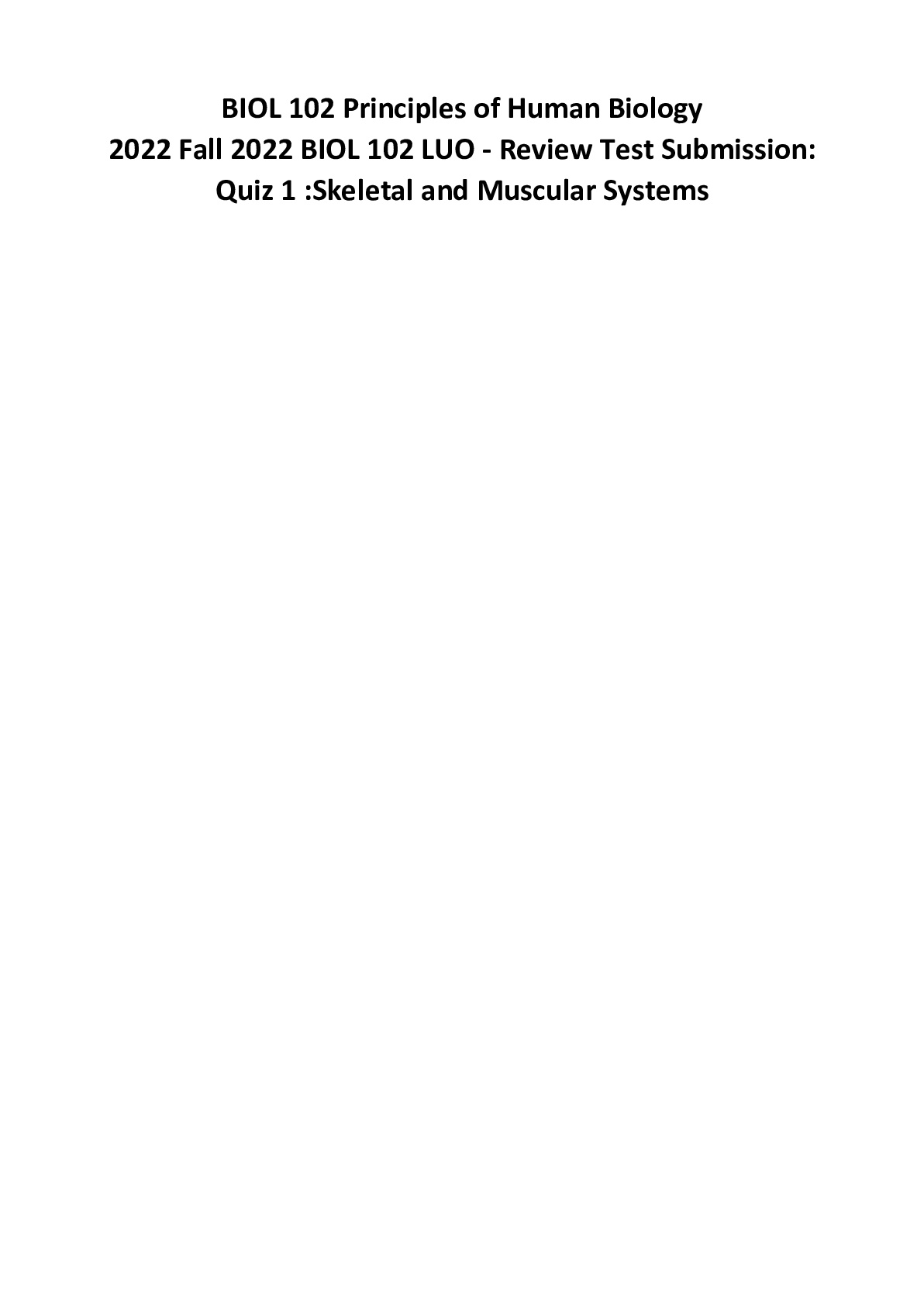
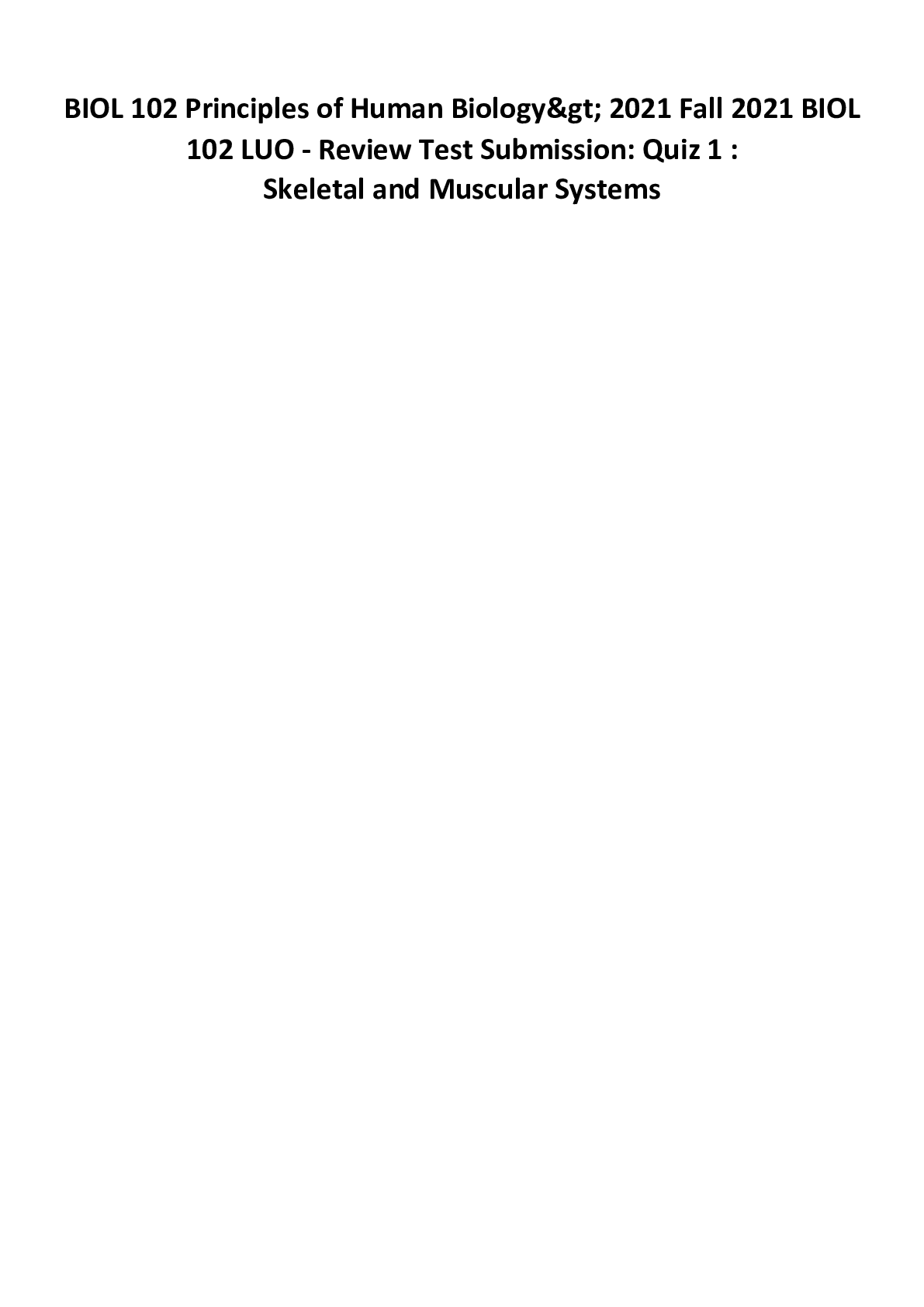
.png)

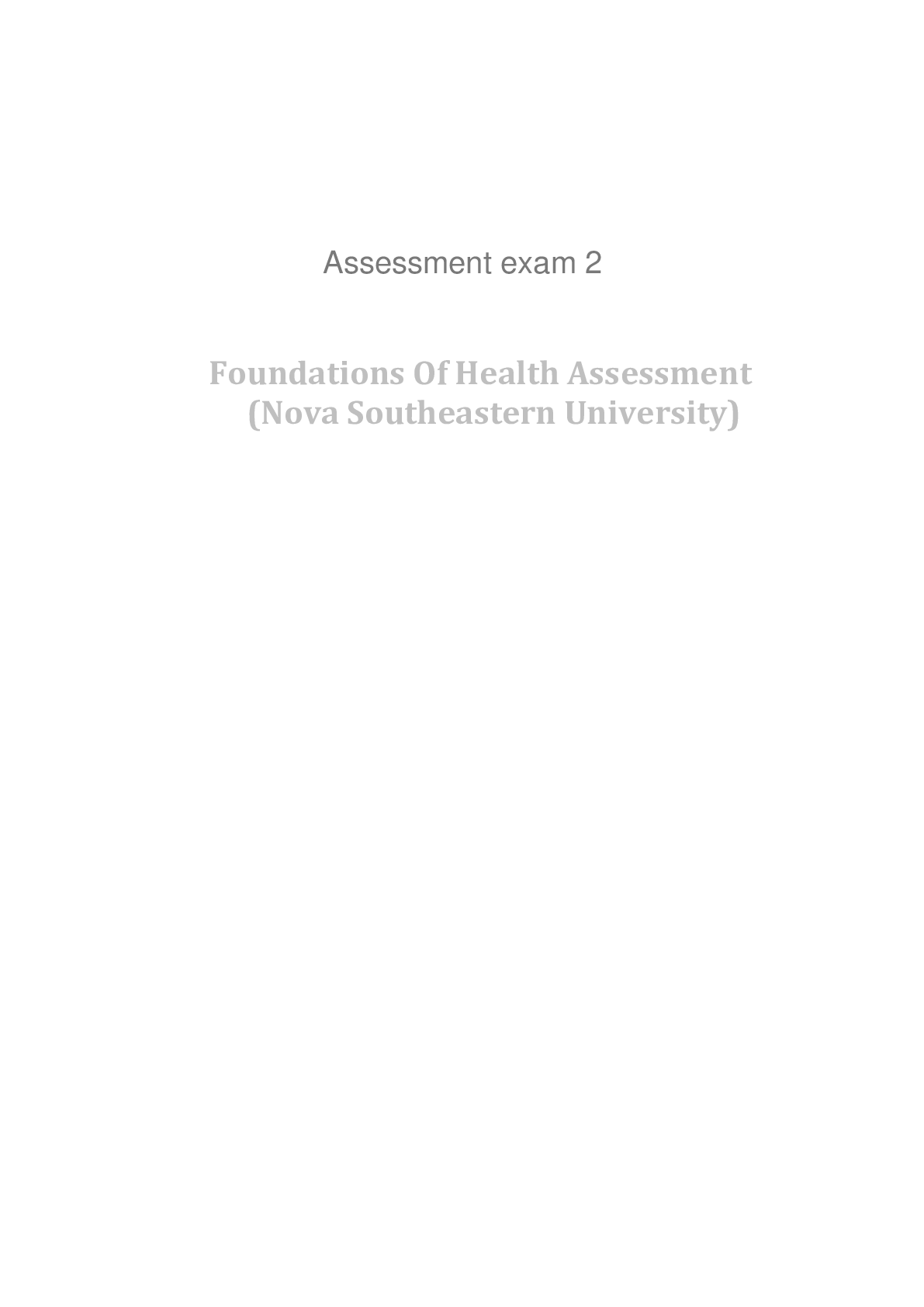
.png)
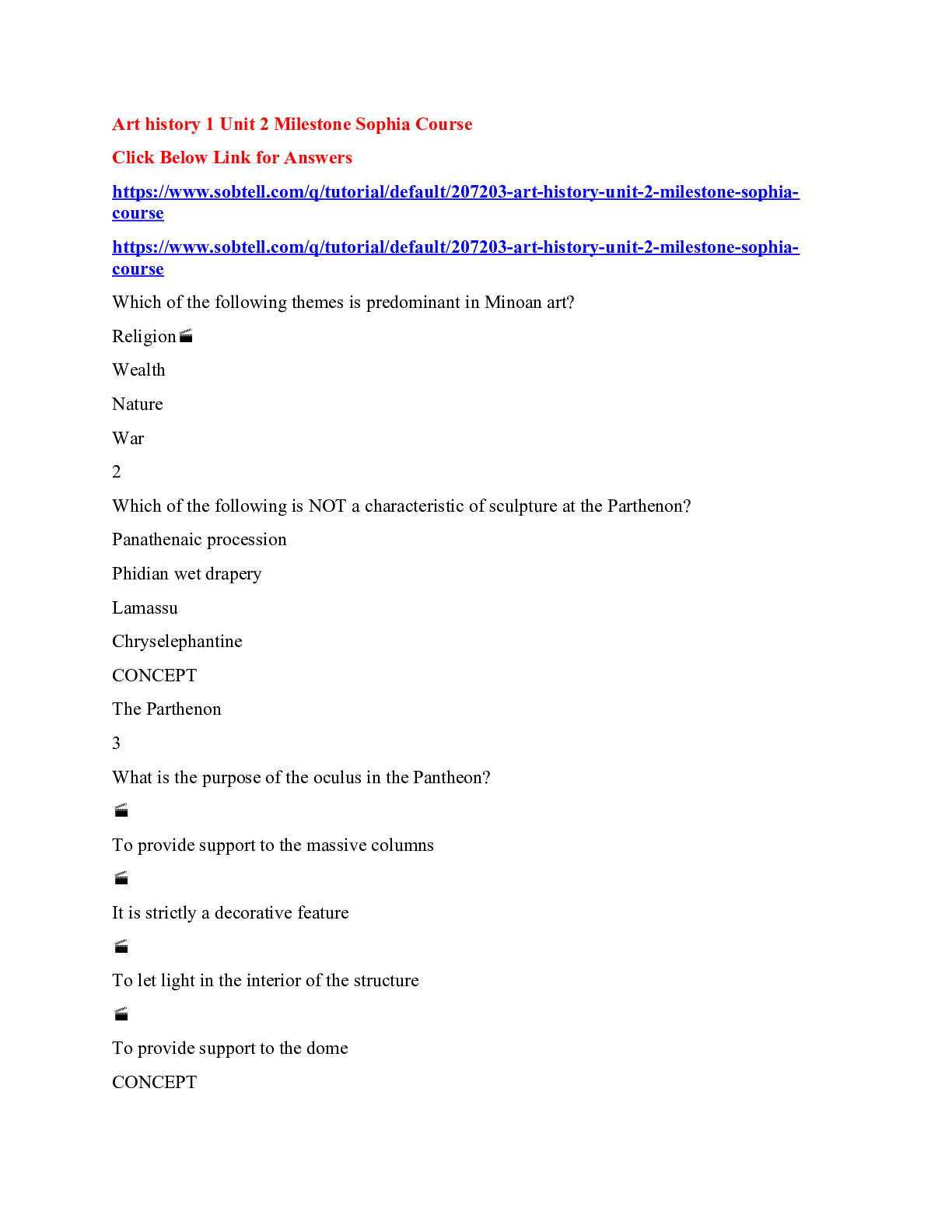




.png)
.png)


